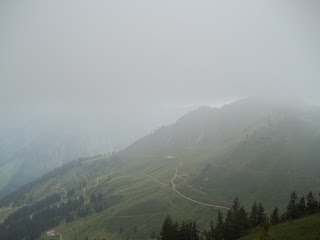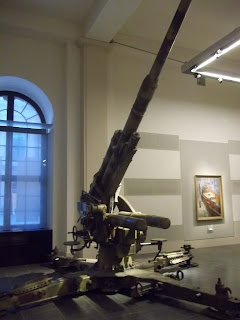The tram station
had to be crowded, or the plan would fall apart. That made 5:26 on a Tuesday
perfect. Unsuspecting middle-class Germans packed the line next to the tracks,
near enough that nobody would dare step in front of them and so that they could
be that much closer to the briefly available doors, which were just coming into
view around the bend. They stared at the approaching train to avoid making eye
contact with the flushed, plump businessmen around them, the lady holding a
cane who had some kind of wart on her forehead, the mustachioed man asking for
money. All they wanted was home, and taking off their shoes. Unfortunately for
them, the monkey wrench to their plans and routines was riding to meet them, a
college newbie out to prove his loyalty to the 1up crew of Berlin. He wore
H&M jeans with a beanie and thick black-framed glasses, indistinguishable
from hundreds of other students in the city, but his laptop case was one laptop
short of utilized.
As the tram
rolled to a stop and the doors opened to a rush of people, Mr. Monkey Wrench
stood up, smiled, and yanked on a bright red emergency brake. In three minutes,
three things would happen. The authorities would arrive, the train would be
cleared for departure, and a band of miscreants that had just given the tram a
new paint job would have disappeared as if through trap doors in a magic show.
From purses, from backpacks, hoodie pockets,
and baggy sleeves suddenly appeared canisters of spray paint. One woman in a
black skirt and business jacket slipped a surgeon’s mask over her face and made
the train her canvas. To her left, a red-faced man with a balding head held a
canister in each hand. With white he laid the background, overlaying it with
bright red lettering. Another was intent on depicting a hand reaching up from
underneath the train. Twelve of the crowd around the train were no longer
waiting for a ride back to their homes, but illegally transforming one of the
state’s prized devices into what they considered a work of art.
Paint fumes
repelled the commuters as if as the crew was spraying bug spray on a swarm of insects.
Some stared in indignation, others in fascination, but almost all stared as
chalky grey paint began to disappear beneath flashy tags and hasty murals.
Gangs and artists at work are two things people are wary of messing with, and
the spectacle in front of them seemed to be some strange combination of both. A
boy in a Chicago Bulls hat whipped out a smart phone and started taking a
video, a smile on his face, as another couple others hurried away to find some
blue-vested official. Their intention would not make a difference.
When the authorities arrived on schedule, all they found was the message left for them and everyone else in the city, emblazoned from top to bottom and door to door like a bold billboard on wheels:
One United People
 |
| At night, a nearby light casts the shadow of a flag on the astronaut's outstretched hand, as if he is holding it. |
All right,
that’s enough prose for one blog post. I had to use my imagination for the
details of that story, so if anyone from the 1up crew of Berlin is an ardent
follower of my blog, I’m sorry for any misrepresentation or mistakes. Think of
it as promotion rather than libel!
In case
you’re wondering, the 1up crew of Berlin is a real group that does things such
as paint trams with military precision. I bring them to your attention because
I think they embody certain characteristics that are essential to the spirit of
Berlin. Because of this spirit, Berlin is recognizably different from any other
city I’ve visited. It’s got kind of a punk feel to it. It’s not necessarily a
beautiful city, but it is modern, and full of excitement. You only need to look
at its past to understand why. Berlin was largely destroyed during World War
II, and mostly rebuilt recently. While Berlin was still cut in half, young
citizens were given exemptions from military service if they lived in Western
Berlin, a small island of democracy surrounded by Eastern Germany that would be
otherwise unappealing. The city filled with college-age kids who left a legacy.
Then when the wall came down in the recent past, others flocked into Western
Berlin, leaving hundreds of residences in East Berlin open without any kind of market.
Squatters and starving artists moved into these residences and gave the area an
edgy, alternative kind of feel that it still has today. Even now, it’s
constantly changing and growing, evidenced by the hordes of cranes that seem to
photo-bomb every picture with a horizon. People are beginning to discover
Berlin, and it’s slowly becoming more expensive, and filling with a new kind of
demographic, a transition that the current residents are fighting. Maybe Rome
could see evidence of its past through the building that had survived for
thousands of years, but Berlin’s history is happening now, this instant. You
only need to look at the differences in the colors of the light bulbs between
Eastern and Western Berlin (for this reason the divide is still visible from
space) or at the raging battles in this city right now.
By the way,
I took most of the photos of graffiti on an “alternative tour” of Berlin, in
which I also learned much of this history lesson. Did you know that within one
night, a wall like the one in the picture above (minus the artwork) was
constructed around West Berlin? One night! These people went to bed like it was
any other night, and when they woke up the next morning the entire city was
behind a twelve-foot barrier.
Along with
the wall, I made sure to visit several other sites in Berlin. I have to say
that the German History Museum was the most interesting place. I could have
easily spent an entire day there. Surprisingly, my American education neglected
to provide me with much knowledge on German history. Of course, we all learned
about these kinds of things:
But Germany’s history is not all about world wars.
Berlin is also the hometown of one of the best fast food
meals that must be in existence.
This delicious food is known as currywurst. It may be a
difficult concept to grasp, but the name comes from a combination of bratwurst
and curry. Mind blowing, right? As a cheap college student, it made for a great
meal beneath the tram tracks, especially when you could get two of these things
with fries for only five euro.
As much fun as I had in Berlin (I went with Hannah and some
other Americans living in Munich, so of course it was fun), I made sure to see
some of the sobering sights as well. I stopped by the Holocaust Memorial, a
good place for pondering. I also visited the topography of terror, a museum
dedicated to the Gestapo and their tactics during WWII. Within, I found
newspaper pages printed in Germany during that time period, Hitler filling the
front page. I saw mug shots of holocaust victims and heard their stories. There
were walls of depressing photos too.
But I'd like to end things on a better note. It's been awhile since I uploaded a blog, and that's because I've been in the Alps, where I couldn't really upload anything to the internet. So here's a preview for my next post.



















































